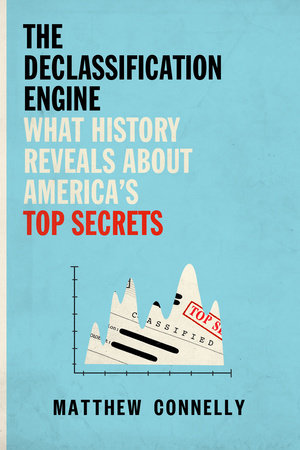The Declassification Engine: What History Reveals About America’s Top Secrets
- By Matthew Connelly
- Pantheon
- 560 pp.
- Reviewed by William Rice
- February 10, 2023
Must every government document be kept under lock and key?

Presidents from both parties have recently sparked scandal by their handling of secret government files. But historian Matthew Connelly argues the real scandal is that the United States overclassifies, under-shares, and cavalierly destroys information about what it does in our name and on our dime. He’s on a mission to change that behavior and has a technological plan to do it.
Connelly’s new book, The Declassification Engine, is both an impassioned indictment of America’s culture of official secrecy and a blueprint for how advanced computer-search capabilities could be used to restore our nation’s traditional transparency. His criticism is for the most part balanced: He allows for the need to guard some sensitive information and debunks notorious conspiracy theories with more plausible explanations (that nevertheless represent dangers of their own).
He makes a compelling case. Hiding, sometimes forever, key details of momentous activities undertaken on behalf of the American people — war; domestic spying; the creation, testing and storage of dangerous weapons — presents multiple perils to life and liberty. Bad policies are allowed to persist; elected leaders avoid responsibility for errors and transgressions; faulty, sometimes weird science and incompetent, sometimes unhinged scientists thrive; and the lessons of history are never learned.
Connelly explains that state secrecy was viewed at America’s founding as a corrupt relic of European autocracy and that the nation’s “ever more radical experiment in open government” only came to a permanent halt with the Japanese bombardment of Pearl Harbor. Our government used the surprise attack, which abruptly pulled the U.S. into World War II, as an excuse to begin building the security state that has continued to grow in the 80 years since. The author says Pearl Harbor also marked the beginning of the practice of officials covering up mistakes — he believes the military was criminally unprepared for that predictable raid — by stamping them “Top Secret.”
Secrecy nourishes what Connelly dubs the “dark state.” The term is reminiscent of but distinct from the imagined “deep state” that engenders so much right-wing anger. “Deep state” theory holds that unelected bureaucrats control the government in defiance of political leaders. Connelly’s “dark state” is no less shadowy but is actually run by elected officeholders — specifically, the president. Though, as candidates, they often promise to let more sunlight into the governing process, presidents (once sworn in) can’t resist the benefits of keeping the curtains closed.
But a lot of mischief can happen in the dark. Though he doesn’t think appointed officials generally pull all the strings, Connelly does believe the military is out of control and cites instances of generals and spymasters withholding information from the commander-in-chief: During the Cuban Missile Crisis, for example, the top brass didn’t tell John F. Kennedy that they had moved the nation’s nuclear posture to one notch below war.
Almost from the moment government secrets began to pile up, there have been efforts to divulge them once it was safe to do so. Yet Connelly points out the practical and political barriers to timely declassification. With the proliferation of information — including secret information — since the Second World War, it’s estimated that it would take a workforce of several million to evaluate all the classified material at the National Archives to see what could be released. Right now, there are 41 employees assigned to that task. Human resources aside, Connelly notes that while classifying a document is always the safe option and is often to a particular official’s personal benefit, “declassification [is] meant to serve everyone, and therefore serve[s] no one in particular.”
Only technology can physically conquer the mountain of mystery and, in the process, make sharing information with the public as attractive as withholding it. The engine of the book’s title is the algorithms that estimate the sensitivity of a document by the presence or absence of certain keywords in its title and via other methods that can grow more accurate with practice (“machine learning”). Connelly and his colleagues have successfully tested out their system on millions of already-declassified State Department cables but can’t interest the federal government in the process for reasons offered up in the book’s disheartening final chapter.
His argument is generally focused, though it occasionally drifts to important but off-topic subjects like economic policies that favor the rich. He also doesn’t acknowledge that — as big a threat as excessive government secrecy certainly poses to our democracy — the scandals he reveals are all secrets that have since been told. The very existence of his book means our society still allows the free flow of information.
But Connelly wants more, and he’s not alone. He quotes a Pentagon panel made up of hardliners like the inventor of the hydrogen bomb, who, over 50 years ago, concluded, “We would have more to gain in the long run by pursuing a policy of complete openness in all matters.” Connelly then offers this startling example: the Cuban crisis of the early 1960s did not escalate to nuclear Armageddon because the Soviets were intercepting U.S. communications and knew our tough talk was mostly a bluff. In other words, he writes, “[B]eing radically transparent — however unwillingly, and unwittingly — was precisely what kept us safe.”
William Rice is a writer for political and policy-advocacy organizations.
